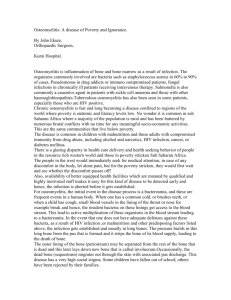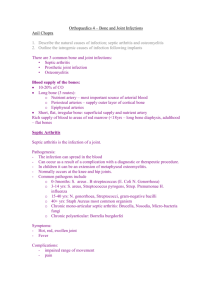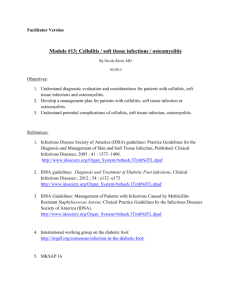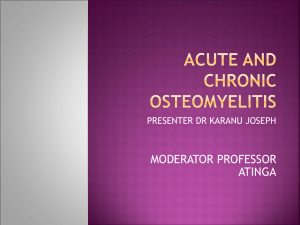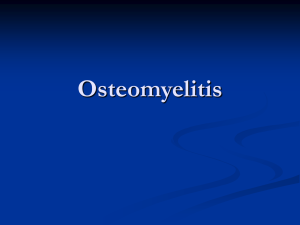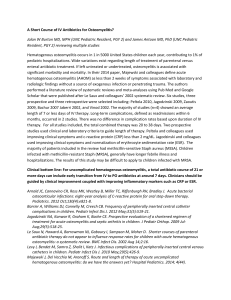Diagnosis - MCE Conferences
advertisement
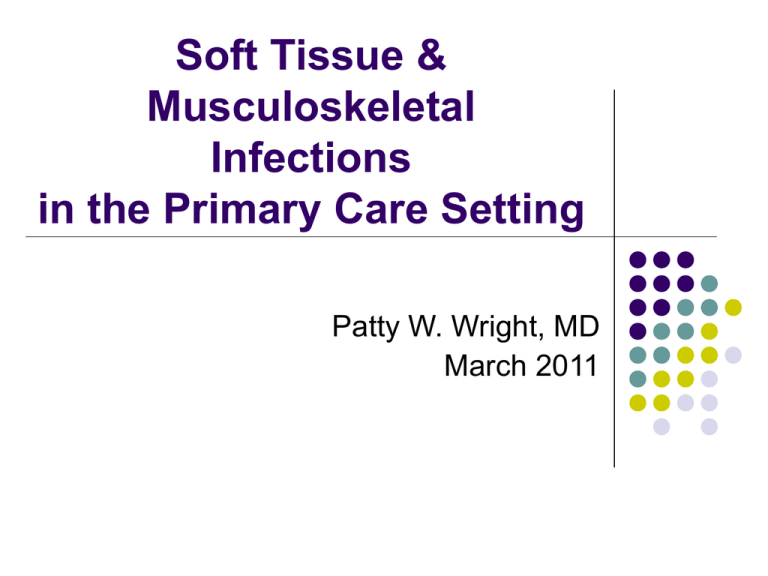
Soft Tissue & Musculoskeletal Infections in the Primary Care Setting Patty W. Wright, MD March 2011 Objectives To familiarize participants with some of the most common soft tissue and musculoskeletal infections in the primary care setting, including their diagnosis and treatment. Case 1 A 42 yo female who works as a housekeeper presents with a one year history of swelling and redness along the borders of her nails bilaterally. What is the diagnosis? How would you treat her? http://missinglink.ucsf.edu/lm/DermatologyGlossary/paronychia.html Paronychia Infection of the skin (epidermis) bordering the nail Typically associated with trauma: Manicures Ingrown nails Dishwashing Thumb sucking http://en.wikipedia.org/wiki/File:Paronychia_argentea_(286232698).jpg Chronic Paronychia Chronic paronychia typically due to eczema Often have superinfection with yeast (Candida) Rx with steroid and antifungal creams If no response, trial of oral antifungals with topical steroids Patient should avoid prolonged water exposure to the hands Consider alternative diagnoses such as psoriasis Acute Paronychia Commonly due bacteria such to Staph aureus or Group A Strep Soaks and surgical drainage usually enough If severe, treat with oral antibiotics http://en.wikipedia.org/wiki/File:Paronychia.jpg Case 2 A 26 yo female hair dresser develops throbbing pain, swelling, redness, & warmth in the distal portion of her index finger. She recalls that she accidentally stuck herself in the finger with her scissors the day before. What is the diagnosis? How would you treat her? http://drhem.com/2009/08/16/hand-case-3-1/ Felon Abscess of the pad (or pulp) of the tip of the finger or toe Significant pain, redness, and swelling in finger tip Most commonly due to S. aureus May spread to bone with resulting infection (osteomyelitis) Most commonly in thumb and index finger Typically related to trauma: splinters, puncture wounds, scraps or abrasions Felon If early: elevation, soaks, and oral antibiotics If late: rx as above plus surgical drainage Culture the fluid to direct antibiotic therapy Consider x-ray to rule out foreign body or bone infection Rx for 5-14 days depending on severity Case 3 A 33 year old female presents with a red pustular lesion on her left 5th finger. The lesion is tender and has been present for almost a week. What additional questions would you like to ask this patient? What pathogens are on your differential diagnosis? Herpetic Whitlow Autoinoculation of HSV 1 or 2 into non-intact skin Health care workers at risk if not using universal precautions Abrupt onset of edema, erythema and tenderness Clear vessicles may coalesce become cloudy Confirm with Tzanck test, viral culture, DFA, or HSV PCR Herpetic Whitlow Typically resolves in 2-3 weeks without rx Treatment with antivirals (acyclovir, famciclovir, valacyclovir) within 48hrs of onset may lessen severity Cover with dry dressing to avoid spread to other areas Recurs in up to 50% of patients, though primary outbreak most severe Case 4 A 47 yo male construction worker with a history of “athletes' foot” presents to the ED with redness, pain, and swelling over his ankle and lower leg. What is the diagnosis? How would you treat him? http://battlegames.wordpress.com/2008/12/ Cellulitis Infection of the skin (dermis and hypodermis) with some extension into the fatty, subcutaneous tissues Local signs: redness, swelling, warmth, and tenderness +/- enlarged lymph nodes Systemic signs may include low grade fevers, chills, and body aches Blood cultures rarely positive (2%) Cellulitis Most common causes are Group A Strep and S. aureus Rx with iv antibiotics (vancomycin) for inpatients Rx with oral antibiotics for outpatient therapy If pt not systemically ill, has a normal immune system, and has reliable follow up and access to antibiotics Remember that trim-sulfa may not be the best coverage for Strep Case 5 A 50 yo male carpenter presents to the ER c/o pain in his hand. He reports that a board fell on his hand yesterday with some mild bruising. He awoke today with pain so severe that he was unable to drive himself to the ED. What is the diagnosis? How would you treat him? Fasciitis / Myositis Fasciitis Myositis Infection of the fascia (thick layer of connective tissue that surrounds the muscles, bones, nerves and blood vessels) Infection of the muscles Rare: 500-1500 cases/year in the US Clinical Presentation Fever, elevated heart rate, & low blood pressure Local signs and symptoms such as swelling, large blisters, crepitus, and pain out of proportion to the exam Fasciitis Imaging studies such as CT or MRI scans helpful if gas present in the soft tissues Negative imaging does not rule out fasciitis Fasciitis Type 1 Mixed infection of aerobic and anaerobic bacteria Seen in post surgical patients, diabetics and patients with PVD Type 2 Monomicrobial infection caused by GAS or MRSA in previously healthy patients Fasciitis Surgery, Surgery, Surgery Re-exploration after 24 hours with repeat debridement, if necessary Blood pressure support and ICU care, if indicated Antibiotic therapy Fasciitis Empiric Antibiotics Target 1. Core antibiotic: Imipenem, Meropenem, Pip-tazo 1. Sensitive Gram positives, Gram negatives & anerobes 2. Secondary antibiotic: Vancomycin, Linezolid, Daptomycin 2. MRSA 3. Clindamycin and IVIG 3. Group A Streptococcus toxin Case 6 An 28 yo male landscaper presents with pain and swelling along the length of his middle finger. He reports that his pain is most severe when he tries to move the finger. What is the diagnosis? How would you treat him? Infectious Tenosynovitis Infection of the fluidfilled sheath that surrounds the tendon Leads to swelling and pain of the finger (or toe) especially with movement http://www.sportnetdoc.com/injury/07-06.htm Acute Infectious Tenosynovitis Kanavel signs for pyogenic flexor tenosynovitis: Uniform symmetric swelling of the digit Digit held in partial flexion at rest Excessive tenderness along the entire tendon sheath Pain along the sheath with passive digit extension Most clinically reproducible sign Acute Infectious Flexor Tenosynovitis Most commonly related to trauma, particularly at the flexor crease Most common pathogens are Staph and Strep Polymicrobial infections possible in DM or immunocompromised May occur following hematogenous spread, particularly with N. gonorrhoeae Early stage may respond to elevation, splinting, and iv abx Acute Infectious Tenosynovitis I&D if… DM Immunocompromised No improvement within 12-24 hrs of abx therapy Gram stain and culture to direct abx therapy Rx empirically with vancomycin and quinolone (ciprofloxacin, levofloxacin) then tailor regimen to cx results Chronic Infectious Tenosynovitis Often due to atypical mycobacterial or fungal infections Empiric therapy is difficult given wide spectrum of etiologies Cultures for AFB and fungi essential to diagnosis and treatment Pathology with special stains may be helpful, but cultures best Case 7 A 44 yo former roofer is paralyzed following a fall with spinal cord injury 5 years ago. Recently he developed a small ulceration on his lower back which has progressed despite local care. On exam, the wound probes to the bone. What is the diagnosis? How would you treat him? http://boneandspine.com/orthopaedic-images/clinical-photograph-of-stage-iv-sacral-bed-sore-in-a-patient-of-cervical-spine-injury/ Osteomyelitis May be acute (progressing over days) or chronic (progressing over weeks to months) May occur from direct spread of infection or spread of infection through the blood stream Hematogenous (20%) Contiguous with vascular insufficiency (30%) Children Diabetic neuropathy Contiguous without vascular insufficiency (50%) Trauma (natural or iatrogenic) Haematogenous Osteomyelitis PAIN is primary symptom Frequently progressive over several months Constitutional symptoms or local edema/erythema less common Long bones most common site in children Vertebrae most common site in adults Single pathogen most likely S. aureus most common P. aeruginosa with injection drug use Osteomyelitis Definitive diagnosis requires bone biopsy Often diagnosed clinically based on exam, labs, and imaging WBC count rarely elevated Sedimentation rate (ESR) and C-reactive protein (CRP) measures of inflammation are useful for serial monitoring www4.path.utah.edu “Probe Test” of Osteomyelitis Obtain sterile probe Gently insert into deepest portion of ulcer Sens = 66% Spec = 85% PPV = 89% NPV = 56% Exposed bone is infected bone Osteomyelitis Imaging – Xrays Cheap and easy Able to evaluate for foreign body Not useful for acute osteomyelitis Radiolucent areas do not appear until 50-75% bone loss Osteomyelitis Imaging – Technetium Bone Scan More sensitive than plain radiography Taken up in areas with Increased blood flow New bone formation May be positive as early as 48 hours after infection Gallium and indium scans less sensitive Osteomyelitis Imaging – CT and MRI scans Excellent bone resolution Hindered by presence of prosthetic material MRI preferred for small bones of hands/feet flickr.com/photos/69918874@N00/2208251162/ Osteomyelitis Treatment typically involves… Surgical debridement followed by aggressive wound care Prolonged antibiotic therapy 6 weeks minimum, may extend for months depending on clinical course IV antibiotics needed for acute osteomyelitis Oral antibiotics alone may be indicated for some chronic osteomyelitis Unless definitive pathogen identified by bone biopsy, broad spectrum coverage indicated Case 8 An 82 year old woman presents with swelling and pain in her left knee. She underwent a total knee arthroplasty 10 years ago for OA with a revision 3 years ago for loosening of the hardware. What is the diagnosis? How would you treat her? Epidemiology of Prosthetic Joint Infections 1-3% of primary joint replacements Knee = 1-2% Hip = 0.3 – 1.3% Shoulder - <1% 3-6% of revision procedures Knee = 6% Hip = 3% Prosthetic Joint InfectionsTiming of Infection Classification Characteristic Early (<3 months) Typically acquired at surgery and associated more virulent organisms e.g. Staphylococcus aureus, Gram-negative bacilli Delayed (3 – 24 months) Typically acquired at surgery and associated with less virulent organisms e.g. coagulase-negative Staphylococci, Proprionibacterium acnes Late (>24 months) Usually associated with haematogenous spread from distant infection Prosthetic Joint InfectionsClinical Presentation PAIN Present in >90% cases Night pain more concerning for infection Start-up pain appears more consistent with aseptic loosening Prosthetic Joint InfectionsDiagnosis Primary differentiation is between infection and aseptic loosening Rely on “totality of circumstances” Clinical exam Laboratory data ESR/CRP Culture of joint fluid Imaging Prosthetic Joint InfectionsTreatment Approach Acute infection (<4 wks) AND stable implant AND no sinus tract… Consider debridement with retention followed by IV antibiotics +/additional PO antibiotics Chronic PJI… Joint removal is necessary for cure Debridement with retention followed by IV antibiotics then suppressive PO antibiotics may be considered in debilitated patients who cannot tolerate joint removal Summary Paronychia & felons are infections of the fingers/toes which often improve with simple I&D and/or po abx Treatment for cellulitis should include coverage of Staph and Strep Fasciitis is a surgical emergency & should be treated with very broad-spectrum antibiotics Acute infectious tenosynovitis is typically due to bacteria; chronic is often due to mycobacteria or fungi Exposed bone is infected bone Osteomyelitis and PJI’s typically require surgery and long-term abx therapy

